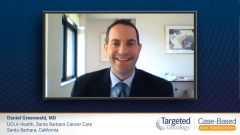
Newly Diagnosed Follicular Lymphoma: Frontline Treatment Decisions
Goals of therapy and variables that affect how patients with newly diagnosed follicular lymphoma are managed with chemoimmunotherapy in the frontline setting, including during COVID-19.
Episodes in this series

Daniel Greenwald, MD: When deciding between available options, treatment considerations involve medical comorbidities and any appreciable contraindications, as well as the patient’s preference for mode of treatment, for example, IV vs oral, as well as the desire to achieve a disease-free interval off of active therapy. In the context of patient discussion around these factors, we almost always consider some form of anti-CD20 therapy as the backbone, and typically with chemotherapy in the frontline setting. Historically, various forms of cytotoxic chemotherapy have been utilized. I think in the majority of centers, bendamustine [Treanda] in combination with an anti-CD20 antibody, like obinutuzumab [Gazyva] remains the mainstay of therapy in the frontline setting outside of the clinical trial. In the frontline setting, the goal of therapy is to achieve a deep remission and to have as long a remission interval as possible. We know that with follicular lymphoma, subsequent rounds of therapy tend to lead to shorter durations of remission, and our expectation, and we believe that if we can achieve a deep and durable remission patients are likely to do better over the long run. I would argue that in the present era we have to consider, for example, COVID-19 infection in deciding when to initiate therapy. For patients who require treatment unequivocally, we give therapy, but if there is some consideration to watch and evaluate or follow expectantly, we will occasionally consider delaying therapy to allow for, for example, response to a vaccine or to minimize the risk of infection. There are practical considerations that come into play or consideration when deciding when to initiate therapy.
I would agree with the approach taken in this patient. She received appropriate therapy with a combination of chemotherapy that has documented activity and an antibody, obinutuzumab. These have been demonstrated in combination to evoke a very deep remission that’s durable for the frontline treatment of follicular lymphoma. There are other considerations. If at all possible, I look for an investigational trial if available. There are trials comparing antibody-based therapy alone to antibody-based therapy with a targeted inhibitor. So when, and if at all possible, I explore the option of a clinical trial. There are patients who have a low bulk or low volume disease who may be able to be treated without chemotherapy as we have utilized in some studies in the past. Again, challenges that can occur are related to the patient’s overall health and their comorbidities. In our hypothetical example here, we’re dealing with a younger patient who had otherwise been healthy, but in a much older patient who may have cardiac problems, renal problems, pulmonary problems, or a history of infection, there has to be tailoring of the approach and that sometimes means altering the chemotherapy schedule or adjusting the treatment in some fashion.
Transcript edited for clarity.
Case: A 45-Year-Old Woman with Follicular Lymphoma
Initial presentation
- A 45-year-old woman presents with a 2-month history of fatigue and abdominal pain, enlarged lymph nodes in her right neck, and a 5-lb unintentional weight loss
- PMH: Unremarkable
- PE: right cervical and axillary lymph nodes palpated ~2 cm; spleen palpable 3 cm below left costal margin
Clinical workup
- Labs: ANC 1.5 x 10^9, WBC 11.7 x 10^9, lymphocytes 41%, Hb 8.7 g/dL, plt 101 x10^9, LDH 305U/L, 3.6 B2M ug/mL; HBV negative
- Excisional biopsy of cervical lymph node on IHC showed CD20+, CD10+, BCL2+, follicular lymphoma grade 2
- Bone marrow biopsy showed paratrabecular lymphoid aggregates, 43% involvement
- Cytogenetics: t(14:18) (q32;q21)
- PET/CT showed right axillary, cervical, and mediastinal lymphadenopathy (2.7 cm, 2.5 cm, and 2.6 cm respectively)
- Ann Arbor Stage IV, ECOG PS is 1
Treatment
- Patient was treated with obinutuzumab plus bendamustine chemotherapy. She completed 6 cycles and treatment was well tolerated.
- She continued on obinutuzumab maintenance.
- 30 months later, she complains of fevers, chills, and decreased appetite.








































